
Variety is a good thing, especially in diet, and adding in quail, beef heart, chicken necks or wings, pigeon, and duck will help her get the variety of nutrients she needs and from a variety of sources. Rotating these so that one food source is not fed for long stretches at a time allows the bird to have variety in her diet and a variety of castings. For the most part, understand what the bird eats in the wild and try to replicate that.
 |
A well stocked falconer's freezer. Aside from a place to store a bird's catches until they can be eaten, this clean and sanitary freezer has several whole organic rabbits, day old chicks, several sizes of rats, adult and juvenile mice, pinkie mice, beef heart, turkey backs, rendered turkey meat, chicken backs, chicken necks, and adult quail. This freezer also has cold packs for first aid or for a cooler to store game on the way back from hunting. |
Perhaps the most important point in feeding your raptor is in evaluating what the food source has been fed. In many commercial production facilities, profit margin is the most important thing. Studies are done on ways to replace certain segments of their diet to reduce costs. Producers are looking to meet a bare minimum. Because of this a trusted food source is a must, especially for breeding raptors. Viable eggs will not be produced if the birds are not on an optimal diet. The grains that the quail and pigeon are fed, the age of the food source, and the supplements they are given all will affect exactly what you are feeding your bird. The diet of the food source you are feeding your bird matters greatly. If the food source you are feeding your bird is not getting a balanced diet, then your bird is lacking. Although the norm in the past, catching rats or pigeons today could be a possible source of disease or toxins to your raptor. Raising your own or purchasing your food from a supplier knowledgeable in feeding raptors is best.
When managing weight, think about how athletes manage their diet and fitness goals, particularly when reclaiming a bird after a moult or illness, and when dialing in the weight. A fat hawk is not always a happy hawk as that weight can put unnecessary stress on ankles and create Bumblefoot problems. Moult weight should not be obese, and flying weight is not starvation. When bringing a bird's weight down to an athletic fitness level for performance, consider holding that weight for three days to let the metabolism adjust to that weight and caloric intake level. Especially with the micro-hawks the tiny amounts of weight change, on the level of one gram or a half-gram, are significant and can make the difference between lack of response and highly responsive. Older birds coming out of the moult do not just need to drop the fat they have laid on during the moult, but add muscle and will need significant exercise and work to add this engine back to their body. High quality food, plenty of hydration, and slow weight adjustments are the mantra to finding the right weight.
Some falconers try to completely strip the fat out of the bird's diet. This will degrade the bird's overall condition. To have a bird with a beautiful set of feathers, that healthy bloom, and the waterproof sheen, there must be fat in the diet. Some fat is necessary in her diet to ensure proper metabolic function, nutrition, and good health. Trimming excessive fat or otherwise removing the fattiest parts can ensure the bird receives more nutritionally valuable food as a percentage of her diet, but avoid attempting to strip out all fat. If you do trim fat off, it can be useful to freeze it into a small cube so that when out hunting you can shave off a little pick-me-up of fast calories for the bird. This can especially be useful for sharp birds or smaller birds.
Unlike cooking for ourselves, muscle is not the only part of the animal that is to be fed. The bones must be fed to the bird for her minerals. Indigestible bones rangle the crop and keep it clean. Splitting open larger bones exposes the rich marrow for digestion. The fur or feathers provides roughage, natural rangle, which naturally cleans out the crop and proventriculus. Tearing and picking at larger bones would help cope the beak and keep it in condition. These birds would eat the entire animal in the wild, and so we must understand their nutritional needs and meet them.
Some general guidelines:
- No frozen or hot food - all food should be defrosted, and ideally warm to the touch
- Avoid "processed" food (ground beef, etc)
- No cooked foods
- Try to defrost food quickly in a warm water bath. This prevents bacterial growth, and will gently warm the food for her to eat. If the frozen food is dropped straight into the water, the water will also rehydrate the meat replacing what water was lost in the freezing process and providing additional hydration for the bird. Food left on the counter to defrost for an extended period of time will develop bacterial growth and can lead to sour crop.
- Avoid defrosting with the microwave as the interior of bones can be hot enough to burn the bird's crop and stomach. If you do microwave to defrost, leave it lay for a half-hour or so before taking it to the bird.
- Most falconers do feed food that is stored frozen. After six months frozen foods do lose some nutritional value. Instead of stocking up and using food over a year, try to use it within six months of the food being frozen.
A general guideline for the amount of food to feed a healthy raptor per day can be computed as follows:
Maintenance Metabolic Rate = 1.5 (78 (weight in kg 0.75))
The window that we want to calculate is represented by these three calculations.
0.7 (1.5 (78 (weight in kg 0.75))) for a completely inactive bird
1.0 (1.5 (78 (weight in kg 0.75))) for a normal bird
1.3 (1.5 (78 (weight in kg 0.75))) for a highly active bird
The equations each need to be worked separately in order to identify an appropriate amount of food, and the bird needs to be monitored in order to identify if the caloric intake is appropriate for the individual.
Let's work an example of a 1200 g Red-Tail Hawk who is healthy and hunting a couple of times a week.
Start with her weight - 1200 g, which equals 1.2 kg.
With your calculator, type in 1.2, multiply this by 1.2, and multiply it again by 1.2 and hit ENTER. Then, hit the square root function and then hit the square root function again. This will give the weight in kg taken to the 0.75 power, which equals 1.1465313. Multiply this times 78 to get 89.429441. Multiply this times 1.5 to get a result of 134.14416 Kcal.
Since there are three options, we need to work the equation three times - we worked it above for the normal amount, which will just equal 134.14416 Kcal.
We need to work the equation once taking the result and multiplying by 0.7 to get 93.900912 Kcal for the completely inactive lower guideline.
We need to work the equation once taking the previous result and multiplying it by 1.3 to get 174.3874 Kcal for the highly active upper guideline.
This means that although we'll want to start by feeding this bird 134.14416 Kcal, this bird may need more food if she is in excellent shape, if it is cold outside, if she has parasites, or if she is exercising heavily. The other two calculations give some guidelines for anticipated caloric needs. Dropping a raptor below the inactive calculated caloric intake may be required, and raising a bird above the highly active caloric intake may be required, but in each case it may also indicate a problem. This is simply a guideline to help calculate some initial estimates for proper nutrition.
Washed meat and stones maketh a hawk to fly, much casting and long fasting maketh them to die.
Simon Latham
One component to a properly functioning gastrointestinal system is also rangle. Rangle both refers to the stones used and the action of feeding the stones. Birds in the wild have been observed purposefully picking up and eating stones to rangle themselves. Frequently food that these birds would be eating in the wild would have bits of grit, sand, or rocks stuck to it. In captivity, we have to step in to make sure the birds gets everything she needs.
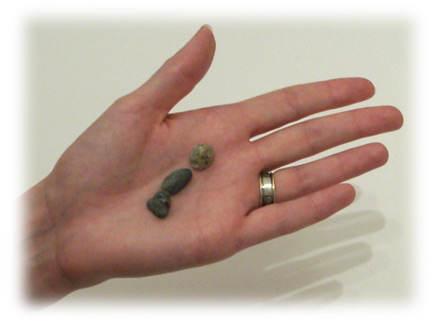 |
Three rangle stones. These were just brought up by a hawk and only had a few hairs and feathers from previous meals; no slimy coating. |
Food sources have different nutritional values. Generally, the darker the meat, the more rich and satisfying it is. Two ounces of pigeon or duck are much more rich than two ounces of rabbit. When you are feeding for maintaining a level of fitness and weight, you will have to take into consideration these relative values so that you are not underfeeding or over feeding. Overweight birds are not more healthy - they can develop ankle problems, leg problems, foot problems, and heart or respirator problems. As general guidelines, never feed raw pork and only rarely (if ever) feed fish to anything but an Osprey or a Bald Eagle.
There has been much discussion around the use of foods packaged for human usage. All meats contain some level of bacteria, such as salmonella, listeria, and e-coli. There have been recalls on meats which are produced for human consumption. However there is no testing for foods produced for animal use, so there is no telling if the levels in those samples would actually be higher. Some argue that the antibiotics and vaccines used on the foods produced for human consumption are more negative to the raptors than the natural bacterial levels. Others would note that there are many natural sources that are infected with a variety of communicable diseases. Raptors in good health should have no problem with normal levels of bacteria as they would encounter them in the wild with every meal. Raptors being rehabilitated might need more preventative measures, though.
Nutritional information provided by US Department of Agriculture and will vary greatly based on producer and individual. All amounts are per 100 g portion.
Pigeon
Pigeon is one of the richest foods you can feed dense with vitamins. Pigeon meat is dark and it is usually a very compact flesh. The warning with pigeons is with disease and the fact that it is a very rich food. Be careful feeding pigeons (or at least their head and crop regions) both due to the potential for frounce and herpes. However a pigeon wing makes an excellent tiring for the bird.
During the moult, hard flying, extensive exercising, cold weather, sickness, or breeding birds need additional nutrients and/or their weight brought up. Pigeon gives a lot of nutrients and is excellent for this. Once weather turns warm, though, the bird may need to be put on a warm weather diet to sustain herself without gaining too much weight that could injure her feet or legs.
Nutrition Data https://nutritiondata.self.com/facts/poultry-products/792/2
| Protein | 18.47 g | |
|---|---|---|
| Total Lipids (fat) | 23.8 g | |
| Energy | 294 kcal |
Duck
Duck is readily available to many longwingers, however the fattiness of it may leave many birds lethargic after a week of this diet and in need of rangle (particularly falcons who tend to be more picky about the amount of roughage they eat). The yellow fat of the duck (and other animals) is considered more nutritious and full of fat soluble vitamins than the white fat of other animals.
Nutrition Data https://nutritiondata.self.com/facts/poultry-products/792/2
 |
A wild duck - notice the thick, yellow layer of fat peeled away to the left and the rich, dark duck breast exposed on the right. |
| Protein | 17.42 g | |
|---|---|---|
| Total Lipids (fat) | 15.2 g | |
| Energy | 211 kcal |
Quail (Coturnix Quail)
Recently quail has become far more available than it was in the past and is easily ordered from many different producers. Some research has pointed to quail as being relatively low in nutritional value, however this may not hold true for all producers as some are more conscious of the quail's diet than others. Some falconers also believe that the quail are too fatty for long-term feeding, or for warm season feedings. This can be mitigated by pulling off the skin and feathers, but others are not as concerned about this aspect.
Quail should be purchased as far into adulthood as possible, ideally 6 - 8 weeks. This gives their bones the chance to fully ossify and puts the calcium into the raptor's diet. Hardy birds such as the Red-Tail can survive in good health for years off this diet, although it is not optimal. More sensitive birds such as the Accipiters do not do well on a diet of pure quail. Some also point to a diet of pure quail as a source of weak bones leading to broken legs and gout.
As with any small animal, digesting the tiny bones can be a problem. Make sure that the bird is not eating bones which have broken into sharp shards and that the bones are not too large for her to put over properly. Some birds have had their crops or proventriculus punctured by a tiny bone and infection has set in unknown to the falconer until an autopsy discovered the cause of death. Some falconers will also remove the lower quail leg and beak to prevent punctures from the beak or toe nails, and removing the feet prevents any fecal matter that the quail walked on from being introduced into the hawk. Some falconers even remove the wings to keep down on the litter matter that the hawk will just discard in the mews as she eats.
Many falconers like to periodically feed the gastrointestinal tract (gut) of the quail to their bird for the beneficial flora and nutrients that it contains. Some birds will not eat this, but there is also no known harm in offering it. Many falconers also remove the feet and the wings as there is little nutritional value in these and there is a small risk of a bird's crop being punctured by the toe nail.
Nutrition Data https://nutritiondata.self.com/facts/poultry-products/796/2
 |
A Coturnix quail; 4.25 oz. |
Frozen adult quail run about 5 ounces and can be purchased for about $1.20 if bought in bulk. This works out to about $3.84 per pound. If you cannot find any local producers, you will be paying for shipping on top of that.
| Protein | 25.1 g | |
|---|---|---|
| Total Lipids (fat) | 14.1 g | |
| Energy | 234 kcal |
Chicken and Turkey Necks or chicken and turkey backs
Charles Knight, an English falconer from the 1920s, and Frank Beebe both swear by chicken heads and turkey necks. Philip Glasier thought chicken heads were particularly good for bird hawks.
Like much commercially produced meat, research points to low nutritional values of chicken as a whole. However, raptors that have a substantial part of their natural diet comprised of birds do very well on this as a staple and wild hawks that feed on poultry do quite well. Necks and chicken wings make great dressing for a lure or tirings. A chicken neck which has been cut open lengthwise as to open the marrow of the bone to the bird also offers more nutrition than otherwise. Chicken and turkey necks with the bones crushed contain a lot of calcium available to the bird and will also satiate her hunger as they tend to be rather fatty. Be careful, though, to cut up necks into smallish pieces or use a hammer to bash the neck bones into small gravel, again checking that there are no sharp edges or points by feeling around it well with your fingers. Some greedy birds will suck down a chicken neck intact making chicken necks dangerous. They can have trouble turning over their crop and develop sour crop or get it caught in the proventriculus, so cut the neck lengthwise first to expose the marrow, then slice into pieces so she cannot choke or end up with the neck stuck in her crop. If you are unable to cut this into proper sized pieces, you can feed this from your hand by getting a clamp from a set of jumper cables in order to hold onto the neck, however without the bones broken up the calcium will not be available to the bird. The neck is very slippery and will otherwise slip through your hand, and the clamp will let you hold it while she works on the meat.
Turkey necks make excellent coping foods in that you can strip off as much meat as you can and give it to the bird to work on. The fats grease her beak and the bone provides friction. It's also good exercise for her muscles. You may want to remove the smallest bones from the neck before giving it to the bird. If you cut the bone or crush it, it is an excellent source of calcium. The bone is very ossified and mature and has a lot of mineral to offer.
Chicken necks may be as readily available as your grocery store (check the frozen area for bags of chicken necks). If you have trouble finding them, look for local suppliers of canine raw food diets as they will normally have this component in their diets, too. Some falconers are nervous about using chicken necks as in the past the neck was the injection site for antibiotics, however there is no strong evidence to write off this food source. Another point about market raised poultry, even that approved for human consumption, is the possibility of salmonella presence. Some will rinse poultry meats in a 10% bleach solution for a few minutes, pat dry, then return to the refrigerator for several hours for the bleach to inactivate, or will rinse fresh chicken and turkey in a 10% bleach solution before freezing. With birds in good health and food from good suppliers this should not be necessary, but with sick or diseased birds, this may be a good practice.
These will run about $1.20 per pound.
Nutrition Data https://nutritiondata.self.com/facts/poultry-products/818/2
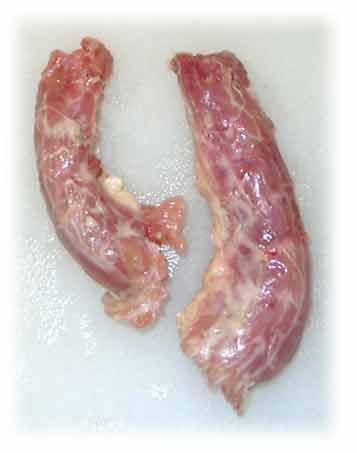 |
Two chicken necks. These two totaled 2.5 oz. |
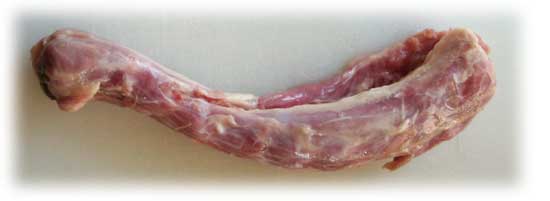 |
One turkey neck. This totaled 10 oz. |
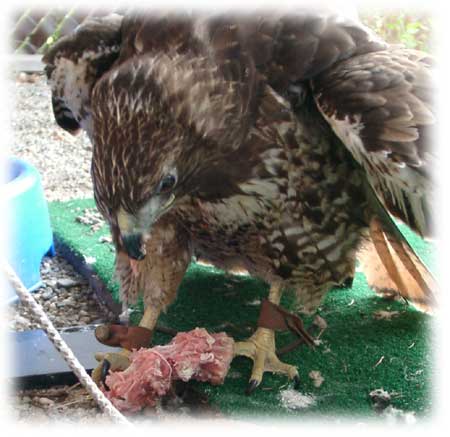 |
A Red-Tail working at a turkey neck. |
Chicken Necks
| Protein | 17.55 g | |
|---|---|---|
| Total Lipids (fat) | 8.78 g | |
| Energy | 154 kcal |
Turkey Necks
| Protein | 20.14 g | |
|---|---|---|
| Total Lipids (fat) | 5.42 g | |
| Energy | 135 kcal |
Chicken and Turkey Backs
Turkey and chicken backs are another source of variety for the diet. These may be as readily available as the local grocery. One advantage of turkey backs is the variety of meat within a single back. There is lighter meat, darker meat, plenty of fat, some amount of organs, and plenty of bone. Some may take a cleaver and chop a chunk off to toss to a bird, however the ribs make me nervous and that makes weighing and estimating the actual amount of digestible food more difficult. I prefer to dress the turkey back out so that all the usable meat is off of it, all the fat is gathered off, and the skin is removed. The ribs and upper vertebrae are tossed away and the lower areas are divided into several sections. These can be tossed to the bird as something to work on that will help cope the beak. As the bird works at these bones and connective tissues, the beak is also benefited by the fats rubbed all over it. The fat can be frozen into a single cube for quick energy for a sharp bird.
Another point about market raised poultry, even that approved for human consumption, is the possibility of salmonella presence. Some rehabilitators will rinse poultry meats in a 10% bleach solution for a few minutes, pat dry, then return to the refrigerator for several hours for the bleach to inactivate. With birds in good health this should not be necessary, but with sick or diseased birds, this may be a good practice.
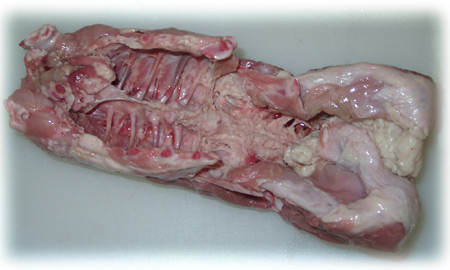 |
A whole turkey back showing the ribs, vertebrae, and pelvis. |
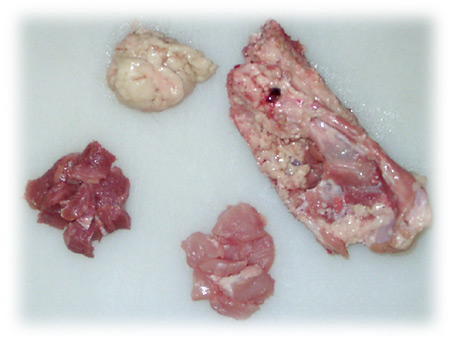 |
The meats rendered from a turkey back. Clockwise from the top is fat, pelvic bone for beak care, lighter meat, and darker meat. |
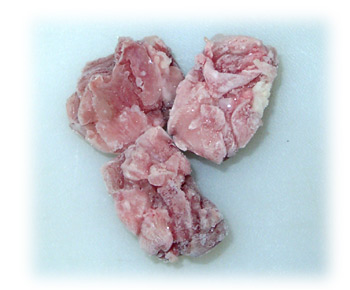 |
Patty Pops of turkey meat. |
Out of this back, there will be three large bone sections that can be tossed to a bird. There will be about 1.75 oz of fat for freezing. There will be 17oz of tidbitable meat, but not without some effort to remove it from the bones. This means that for the actual meat the price for turkey back meat is almost $2 per pound.
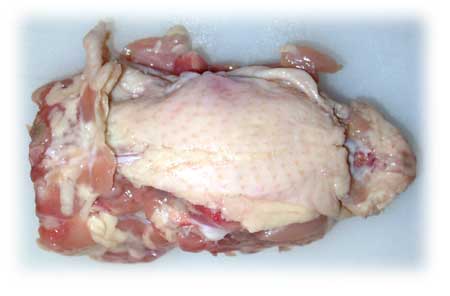 |
A whole chicken back. Notice the amount of skin and fat that is attached. |
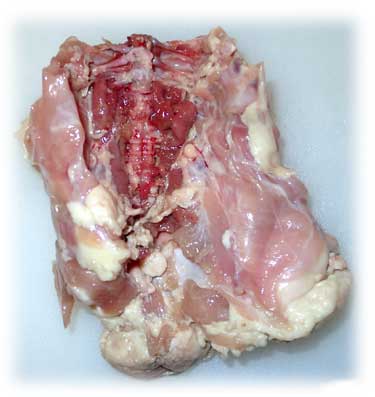 |
A whole chicken back. Notice the dark meat available on the inside. |
Rabbit
Rabbit makes an excellent sustainable diet for Red-Tails and almost any bird. It is not as rich as some other foods, but the fully ossified bones of adult rabbits give a bird what is difficult to find and balance in other food sources. Wild rabbit that the bird has caught makes a good and cheap food, however care should be taken to make sure that the food you are feeding is healthy. Liver flukes are common in rabbits as are worms. Some rabbits carry coccidia, and I have seen rabbits caught in the field with large tumorous growths or infections. These should be avoided completely.
Rabbit has more substantial bones and, as a result, care will need to be taken to make sure the bird does not cut herself on a sharp edge or choke. A tiny rib like that can cut the inside of the bird's mouth letting an infection take root that will almost mimic frounce. When cutting up food for the bird, trim the rib cage off the vertebrae as close as you can get so that the spine and meat attached comes off as a single column without pointy ribs sticking off. The ribs themselves can be cut into several pieces to ensure that they do not get stuck in the bird's crop or proventriculus. The longer bones of the leg are great to feed, but take care to separate the legs at the joint, or even snip the leg bones in half to prevent a bird from taking a whole leg into her crop. Difficulty in putting over a crop and sour crop can result from this. I also remove the lower jaw prior to feeding as there is little meat there and it is one bone that will separate and could cause trouble while eating.
The rabbit organs (heart, liver, kidneys, lungs) are excellent food for the bird, although the gastrointestinal tract is not fed to her. Remove the GI tract whole so as not to contaminate the meat and feed the organs. The rabbit head makes an excellent meal for the bird and helps keep the beak trim and in shape. A rabbit front leg (skin on) that has had the leg bones crushed up into an almost gravelly consistency makes an excellent rangle.
Many have noticed that when their bird is eating a diet heavy in rabbit, the cere and feet become much more pale.
Rabbit quickly dries out, and if the rabbit is being frozen it is best to remove the GI tract and freeze it whole with the skin on. Even if the rabbit is fresh and in the refrigerator it will dry out quickly. Moistening the meat will help ensure that it stays hydrated.
Domestic rabbit will run $1 per pound to $3.00 per pound. Local producers can usually be found at farmer's markets or canine raw food providers. If you cannot find any local producers, you will be paying for shipping on top of that.
Nutrition Data https://nutritiondata.self.com/facts/lamb-veal-and-game-products/4649/2
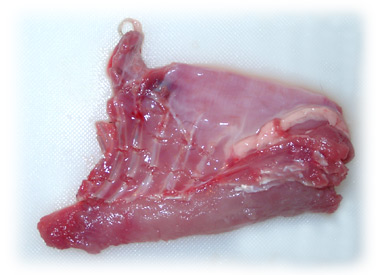 |
Rabbit ribs that have been cut off the vertebrae. The ribs have then been snipped into segments to prevent them from being caught in the bird's mouth or crop. This side of the rabbit will then be cut into tidbits. |
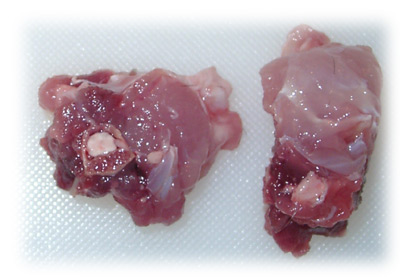 |
Two medallions cut from the rabbit vertebral column. These are cut in part to allow her to put over her crop easily and in part to expose the marrow from these bones and allow them to be digested better. |
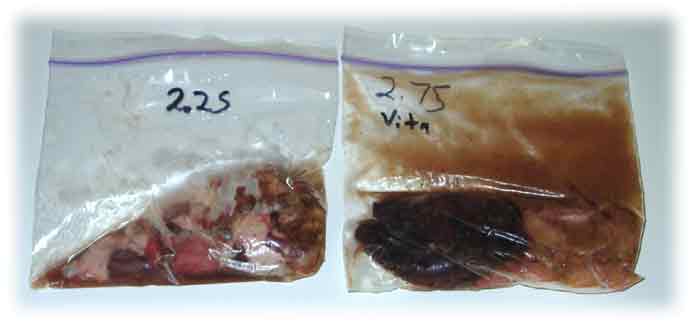 |
One rabbit may last a single hawk a week or more. Butchering and rendering it immediately after caught (or defrosted if it is a domestic rabbit) will help ensure that you use all the food and that the bird gets fresh food. Here rabbit has been divided into ziploc bags pre-weighed for a variety of dinner weights. It is easier to add additional water or blood to this meat in the bag than in an ice cube tray. Additionally, Vitahawk has been added to one bag. This is a particularly useful way to feed your hawk if you are going on vacation. Your babysitter then just needs to drop a bag into warm water to defrost and toss the contents to your bird. |
Wild Rabbit
| Protein | 21.79 g | |
|---|---|---|
| Total Lipids (fat) | 2.32 g | |
| Energy | 114 kcal |
Domestic Rabbit
| Protein | 20.05 g | |
|---|---|---|
| Total Lipids (fat) | 5.55 g | |
| Energy | 136 kcal |
Jackrabbit
Jackrabbit tends to be leaner than quail but contains more fat than cottontail (wild) rabbit.
Jackrabbit
| Protein | 21.9 g | |
|---|---|---|
| Total Lipids (fat) | 2.4 g | |
| Energy | 153 kcal |
Pheasant
Pheasant has been called a "negative calorie" food as it is not nearly as fattening as other meats. It is therefore beneficial if you want a bird to have a huge crop and feel positive for a training session and still keep her at weight.
Nutrition Data https://nutritiondata.self.com/facts/poultry-products/792/2
| Protein | 23.57 g | |
|---|---|---|
| Total Lipids (fat) | 3.64 g | |
| Energy | 133 kcal |
Starling
Starling is a darker meat, but often lacks the fat that other small birds have and therefore is thought to lack sufficient fat soluble vitamins to be the sole food source for the smaller hawks and falcons. Starlings are a great food, though. Many falconers have concerns about feeding starlings. Starlings are often seen as pests, and may have been poisoned posing a potential hazard as a food source. Starlings also tend to group at locations such as feed lots, which is where many trap them for sale as food. These may be dirty or caked in manure and carrying much bacteria. And starlings have a hard, sharp beak and nails which could perforate a crop or GI tract. Many falconers will not feed starling without knowing where they are coming from to ensure no poisons are used at the location, although that doesn't eliminate the risks. They also insist on having clean birds that do not have manure on them, and will cut the beak and legs off prior to feeding to a raptor. Many others have never encountered a problem in feeding starling to their raptors.
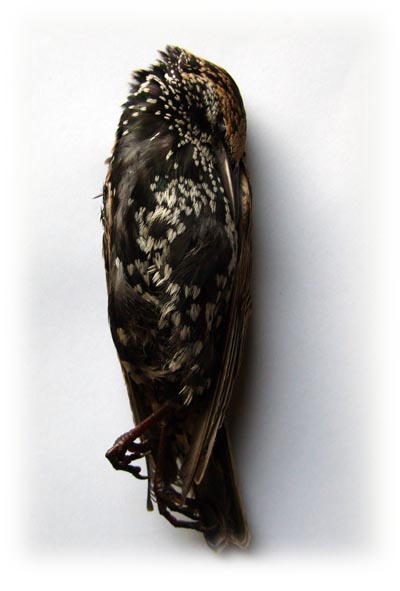 |
Starling that has just been defrosted. |
 |
Starling opened showing the breast meat. |
Poultry Organ Meat
Organ meats contain nutrients not found in other meats and in a ratio not found elsewhere. Chicken gizzards are lean, easy to weigh, tie to the lure easy, make good tid-bits, and you can feed a lot of them and still be on weight the next day.
Be very careful feeding any thyroid to the bird, especially beef thyroid. The thyroid can be fed as a way to bring the moult on, but can also be used incorrectly and to the detriment of the bird. If you intend to use thyroid to bring on a moult, research proper feeding dosages for your species.
Chicken Gizzard
| Protein | 18.19 g | |
|---|---|---|
| Total Lipids (fat) | 4.19 g | |
| Energy | 118 kcal |
Chicken Heart
| Protein | 15.55 g | |
|---|---|---|
| Total Lipids (fat) | 9.33 g | |
| Energy | 153 kcal |
Chicken Livers
| Protein | 17.97 g | |
|---|---|---|
| Total Lipids (fat) | 3.86 g | |
| Energy | 125 kcal |
Turkey gizzard
| Protein | 19.14 g | |
|---|---|---|
| Total Lipids (fat) | 4.58 g | |
| Energy | 118 kcal |
Turkey Heart
| Protein | 17.13 g | |
|---|---|---|
| Total Lipids (fat) | 4.79 g | |
| Energy | 113 kcal |
Turkey Liver
| Protein | 17.84 g | |
|---|---|---|
| Total Lipids (fat) | 16.36 g | |
| Energy | 228 kcal |
Beef Heart
Beef heart is a dark meat with little fat, although it is not a balanced food source for calcium and phosphorus. It is easy to get a big chunk of meat and use it while manning a bird. It also holds moisture well and is easily cut into manageable tidbits. You can easily get 50 - 60 tidbits out of one ounce of beef heart making it easy to have lots of training opportunities. It is readily available from most grocery stores and freezes well. Beef heart is clean and self-contained as it is a whole organ, and is a rich, red meat.
Beef heart is not a well balanced food as it is an organ meat, although many falconers have been known to only feed beef heart and supplement and have very healthy birds for years. It is lacking in calcium, but can easily be supplemented.
One convenient way to store beef heart (or really any meat) is to slice it into slices, measure out one ounce portions, and gently press into an ice cube tray. If you get the trays with large ice cube areas they tend to hold right at one ounce of meat. It is easy to pull the right amount out of the freezer and quickly defrost them in warm water without having to deal with large portions that will need to be kept beyond the defrosting. I call these Patty Pops. Just tuck the ice cube tray into a plastic bag and once they are all frozen dump them into a ziplock freezer bag to prevent freezer burn.
I have tried sealing the pops with water to prevent freezer burn, but that tends to spill all over the freezer and get you in trouble with other members of the household.
Nutrition Data https://nutritiondata.self.com/facts/beef-products/3465/2
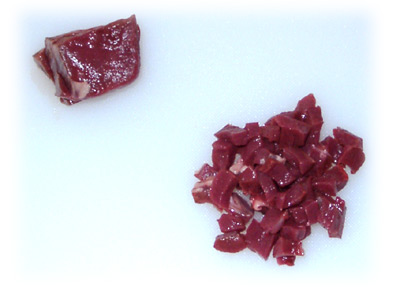 |
A one ounce cube of beef heart and one ounce of beef heart tidbits cut into 60 tidbits. |
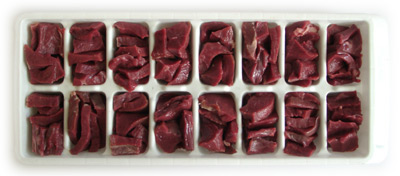 |
Patty Pops |
Beef heart typically runs about $1.49 per pound.
| Protein | 17.05 g | |
|---|---|---|
| Total Lipids (fat) | 3.78 g | |
| Energy | 117 kcal |
Day Old Chicks (DOCs)
One day old chicks are convenient, but are deficient in calcium and other nutrients needed to keep a hawk healthy. A diet of DOCs for years can bring on disease in raptors and reptiles, and some falconers believe that relying on this has lead to heart attack in birds due to their high levels of fats. Avoid DOCs for eyasses and breeders. DOCs only have between half and 2/3s the nutritive value of an equal weight of older chickens or other foods. If you want to feed DOC's and better balance the nutrients for a single food source, you can remove the yolk sac, and supplement them with straight calcium. It is the yolk that causes problems due to the high levels of phosphorous that interfere with the calcium levels in the bird. However, it is the yolk which also gives much moisture to the DOC and therefore will help keep a bird hydrated. DOCs as one component of a varied diet are fine to be fed in their entirety.
A very good food source would be to buy day old chickens, brood them for a few weeks making sure to feed them an excellent diet (supplemented with supplements such as calcium, bone meal, Vionate, and super blue-green algae), then kill and freeze them. Leave the skin and feathers on them and wrap them individually in freezer bags to prevent freezer burn.
Many falconers like to feed the quail gastrointestinal tract for the flora that it contains. Day old chicks do not have much of this flora developed and there is little benefit in it. However, this also means that fewer bacterial infestations have been allowed the opportunity to take hold. DOCs also tend to give the skin and cere and orange-ish coloration.
 |
Day Old Chicks |
Squirrel
Squirrel is a relatively lean meat, like Nutria or rabbit, and makes a good sustaining food. The skin is very tough and will cause the bird to work it over well and wear at the beak. The fat tends to be exposed and can be removed, although I have observed the benefits to the bird's beak and talons from working the fat against them.
 |
Squirrel haunch and torso with organs |
Squirrel
| Protein | 21.23 g | |
|---|---|---|
| Total Lipids (fat) | 3.21 g | |
| Energy | 120 kcal |
Mice
Mice (and sparrows) contain a lot of castings each, yet do not have a great deal of muscle and organ. A hawk must eat a lot of these to survive. Mice do contain a large amount of gut and entrails compared to the whole of the mouse, and so they are not a nutritious as many other foods. Sparrows also may carry frounce, although it is far rarer with them than pigeons.
Ordering mice will run about $0.59 per mouse. For weanling mice, 6 random ones weighed out to 3.25 ounces. Estimating the price out, this is roughly $11.52 per pound for weanling mice. For jumbo adult mice 4 random adults weighed 4.25 ounces making a pound of jumbo adult mice $8.96.
 |
Mice - these six weanling mice weighed a total of 3.25 oz. |
Rats
Assuming a medium rat is roughly 3 oz, it takes 5.3 rats to equal one pound. At $1.10 per rat, this is roughly $5.87 for a pound of rats. Rats do contain a large amount of gut and entrails compared to the whole of the rat, and so they are not a nutritious as many other foods. I have also noticed that fresh castings from rats are noticeably more stinky than from anything else.
 |
This medium rat weighed 3.25 oz. |
Sparrows
Sparrows are full of vitamins! Birds like the Merlin, Cooper's Hawk, or the Sharp-Shinned Hawk almost require sparrows as a large part of their diet, at least a sparrow once a week or on some schedule helps keep the bird in top form.
Insects (Crickets, grasshoppers, mealworms)
This would only be used for a raptor that has insects as part of her diet in the wild, such as Kestrels or other small raptors. Gut loading increases the overall nutritional value for the bird. Gut loading typically uses a calcium-fortified liquid fed to the crickets prior to feeding the crickets to the bird. Insects can be purchased and raised in an aquarium or can be purchased pre-packaged and fully gut-loaded.
Fish
Most birds used in falconry are not naturally eating many fish in the wild. Some of the more opportunistic hunters, such as Red-Tails, will take the occasional fish, but it is not that common. Birds like Osprey and Bald Eagles eat a diet heavy in fish and are built to digest it.
Fish is not an appropriate food source unless you are feeding a bird specifically built to digest fish - they tend to have longer intestinal tracts for this purpose. Most fish meals should be supplemented with vitamin B1. Beware of fish even for these species, though. A slightly turned fish can make a bird sick and even kill her.
Other
Road kill may also be used to feed raptors, although be careful. The animal was in an unknown condition and may have been poisoned or sick prior to its death and spoilage may have occurred after its death. Game that has been shot may also be used, but beware of the risk of lead shot. Some of these species are legal to hunt or trap and make a good sustaining food, or a good food to be rotated in occasionally or for a particular reason.
Beaver is a rich, fatty meat, but much of the fat can be trimmed off. Beaver has been noted to produce an almost blueish tint to the cere and feet. Some falconers save their beaver meat for late spring and feed this to their birds for a few weeks to help the moult jumpstart.
Groundhog is known to be very fatty, very dark, and very rich and promotes a quicker moult, sometimes causing a double moult where newly grown feathers are suddenly dropped if fed too much. The meat is particularly smelly, but is excellent food to start a moult or feed when the bird needs extra nutrition, such as in the middle of winter.
Perhaps the most important part of a healthy diet is clean, fresh water. Bathpans may be unnecessary as a source for drinking water as raptors are very efficient at extracting the maximum amount of water from their food sources. Most raptors can extract almost 1 gram of water for every gram of fat metabolized. In fact, along with the fluids from the prey, this metabolic water can sustain an average raptor, although not in optimal health or under all conditions. In the winter bathpans may not be practical as they allow a bird to bate into it and possibly freeze. However, dehydration is serious and will reduce the raptor's ability to process solid food and can result in crop stasis (sour crop). Freezing food removes water from the meat, so if you feed frozen food, be sure to rehydrate it or provide additional hydration in some way. Their water intake can be supplemented by soaking tidbits in water or soaking the feathers or fur of their food with water, thus putting more water into the system than the diet alone would have provided. "Water bombs" can be made by cutting small pieces of rabbit skin with the fur left on and then soaking them in water. These can be fed to the bird without resulting in much additional weight gain, but will bring water to the gut. Training a bird that a squirt bottle near the mouth will provide her with a stream of water can also help keep her fully hydrated. A Cool Whip container is the perfect container size to train a bird to drink out of. Start with a shallow fill of water and drop a few tidbits into the container. Let the bird "bob for tidbits". She will quickly figure out that she can drink this way. If it is hot out and you want to induce a bird to drink, or if you just want to make sure she is hydrated enough, have her bob for tidbits. Barred Owls are noted as being particularly susceptible to dehydration.
Nutrition isn't just the solid foods you feed, but the whole intake of the bird. This includes providing good, clean water on a regular basis and ensuring that the bird is well hydrated. Bathpans are not the only way to do this, and just providing a pan isn't a guarantee that the bird is getting enough water. You must take responsibility for ensuring the bird in your care is properly hydrated.
Supplements must be used with care as they can do more harm than good if they are used incorrectly. These additives and food sources are not to be used daily for extended periods of time because they are imbalanced. But it is the imbalance that allows the body to extract what it needs that it is not getting in the daily diet.
There are two major nutritional deficiencies that raptors most commonly displayed.
If your bird is standing staring at the ceiling or with her head backwards over the shoulders - most likely there is an inflammation of the brain caused by a lack of Vitamin D. This is commonly called Stargazing Syndrome. The vitamin deficiency can be addressed by feeding a whole food diet and using raptor specific vitamins.
The other is less obvious until a bone breaks from the de-ossification. A diet that is not balanced with the proper amount of Calcium, Phosphorous, and Vitamin D will lead to weaker bones and potentially be a root cause of broken bones.
The most widely used vitamin supplements for raptors are VitaHawk, Raptor Boost, Vionate, Nekton-S, and Quick-Bio. Some falconers feed a small amount every day, others feed a small amount once a week. Some falconers begin the moult by adding 1/4 tsp of honey to the bird's food. Others occasionally make a mixture of Aloe Vera, Cod Liver Oil, and honey for occasional supplementing. Some have tried supplementing with Red Palm Oil, called Sunshine Factor, about 1/4 tsp a few times a week.
Some falconers look to liver, particularly quail liver, when they are concerned there may be a fecal impaction or a hard fecal causing problems.
After treating a sick bird, many times her beneficial GI bacteria has also been destroyed. Raptor Boost contains live, beneficial bacteria that may help in rebalancing her system. Some vets also recommend over-the-counter human capsules to sprinkle over their food (ensure the contents are "Live" or "Active" lactobacillus). Benni-Bac (Avian Lactobacillus) can be used in the same way.
Calcium is one nutrient that is difficult to properly balance in the raptor's diet, especially if the bird is a breeder. Calcium cannot just be added to any food source as it must be balanced with the calcium and phosphorous that is there. Too much phosphorous will cause the body to lose calcium, and vice versa. Calcium can be supplemented through oyster shells scattered on the ground allowing the bird free choice to ingest. Egg shells can be baked at 350° for 25 minutes and then crumbled over the bird's food. Calcium gluconate and calcium carbonate have the most available calcium. Although bone meal has been a traditional method of supplementing calcium, in recent years there has been much discussion about the rendering mechanisms that are used to get every piece of meat off the bone. The chemistry and heat involved in this has been thought to leave the bone less nutritious than previously. Because of this it may be best to go with a more substantial and measurable source of calcium. Commercially prepared calcium is the safest as there is a guaranteed analysis that can be safely calculated and balanced with the bird's diet and other supplements. One commercial preparation used for dogs, horses, reptiles, and birds is Osteo-Form SA powder by Vit-A-Flex. Tums can also be crushed and sprinkled over food to provide calcium.
Osteo-Form SA Contents per 350 grams: Calcium, not more than 32.4% Calcium, not less than 27.0% Phosphorus, not less than 16.5% Vitamin A 115,000 IU Vitamin D3 11,500 IU Ingredients: Bone ash, vitamin A acetate, cholecalciferol (source of vitamin D3), calcium carbonate, calcium phosphate dibasic, soy flour, ascorbic acid, bone meal, and stabilizers.
Rep-Cal is another calcium supplement and comes in two versions, one with Vitamin D3 and one without. This is not to be confused with Reptocal which also is a calcium supplement, but contains phosphorous, which should be unnecessary for most balanced raptor diets.
Osprey and other fish-oriented birds have specific dietary needs. Seatabs are an excellent supplement for their diets when needed.
Egg yolks are also sometimes used on the raptor's food, although it is difficult to get a substantial amount into the bird once the yolk has broken. It is particularly good for birds rehabilitating from an illness. Some birds absolutely love egg yolk and others merely eat it.
Egg yolks
| Protein | 15.86 g | |
|---|---|---|
| Total Lipids (fat) | 26.54 g | |
| Energy | 322 kcal |
Some falconers have experimented with thyroid pills or feeding beef thyroid glands in an effort to get the moult started, particularly in individuals who are observed to have a delay in their moult beginning. This should be done with extreme caution as there are no good guidelines for such supplementation. Some report that they can feed two beef thyroid glands to their 600 g bird, but cannot feed a second set of two thyroids any sooner than one month later else the bird's moult will kick to blow most of the feathers making her uncomfortable. Some falconers have been able to use this successfully, but there is no published set of guidelines that can be used to understand the potency of the thyroid, the amount to feed a bird, and the frequency to feed it.
Nutritional information provided by US Department of Agriculture and will vary greatly based on producer and individual. All amounts are per 100 g portion, and all Calories are Kcal/100g portion.
Additional nutrition information https://gunnersden.com/hunting-game-nutrition-value/
Additional nutrition information http://ushotstuff.com/wg/Nutritional.htm
Additional nutrition information https://fdc.nal.usda.gov